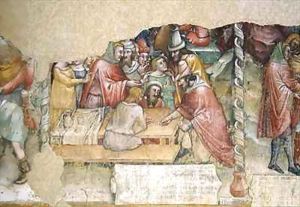Jacopo da Bologna Paintings
Jacopo da Bologna was a significant Italian composer and musician of the medieval era, flourishing from the mid-14th century, around 1340, until after 1386. Not much is known about his early life, including his exact birth and death dates, which remain speculative. Nevertheless, Jacopo's contributions to the musical landscape of his time, particularly within the context of the Italian Trecento and the Ars Nova movement in Italy, have been well documented through his surviving works. He was part of a generation of composers who were instrumental in developing the Italian madrigal, caccia, and ballata, forms that were central to the secular music tradition of the period.
Jacopo's music is preserved in several important manuscripts, including the Squarcialupi Codex, which is one of the richest sources of Italian medieval music and contains a substantial number of his compositions. His work is characterized by its lyrical melodies and complex polyphonic textures, showcasing a mastery of form and an innovative approach to composition that was ahead of his time. Jacopo was highly regarded by his contemporaries, and his influence extended beyond Italy, contributing to the development of the Ars Nova style across Europe.
Apart from his musical legacy, little is known about Jacopo's life. Records suggest that he was active in the courts of northern Italy, possibly serving in the Este court in Ferrara, a significant cultural and political center during the 14th century. This association with the Este court would have placed Jacopo at the heart of one of the most vibrant artistic environments of his time, providing him with ample opportunities to develop his art and interact with other notable figures of the Italian Renaissance.
Despite the lack of detailed biographical information, Jacopo da Bologna's enduring legacy lies in his music. Through his compositions, he played a crucial role in the evolution of Italian secular music, and his works continue to be studied and performed today, offering insights into the musical and cultural practices of the Italian Trecento.
